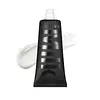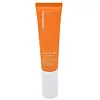What's inside
What's inside
 Key Ingredients
Key Ingredients

 Benefits
Benefits

 Concerns
Concerns

 Ingredients Side-by-side
Ingredients Side-by-side

Water
Skin ConditioningSilica
AbrasivePropanediol
SolventNylon-11
Pentylene Glycol
Skin ConditioningNiacinamide
SmoothingPolyglyceryl-10 Diisostearate
EmulsifyingDicaprylyl Ether
EmollientCorn Starch Modified
AbsorbentBakuchiol
AntimicrobialParfum
MaskingHamamelis Virginiana Water
AstringentButyrospermum Parkii Butter Unsaponifiables
Skin ConditioningLens Esculenta Seed Extract
Skin ProtectingShorea Robusta Seed Butter
EmollientCoffea Arabica Seed Oil
MaskingGlycine Soja Oil
EmollientTocopherol
AntioxidantMoonstone Powder
Skin ConditioningGlyceryl Undecylenate
EmollientEthyl Stearate
EmollientEthyl Palmitate
EmollientEthyl Oleate
EmollientEthyl Linoleate
EmollientAcrylates/Beheneth-25 Methacrylate Copolymer
Ethyl Macadamiate
Skin ConditioningMalic Acid
BufferingSodium Carbomer
Emulsion StabilisingSaccharide Isomerate
HumectantSodium Hyaluronate
HumectantSodium Hydroxide
BufferingTrisodium Ethylenediamine Disuccinate
Ethylhexylglycerin
Skin ConditioningGlyceryl Caprylate
EmollientPhenoxyethanol
PreservativeLinalool
PerfumingWater, Silica, Propanediol, Nylon-11, Pentylene Glycol, Niacinamide, Polyglyceryl-10 Diisostearate, Dicaprylyl Ether, Corn Starch Modified, Bakuchiol, Parfum, Hamamelis Virginiana Water, Butyrospermum Parkii Butter Unsaponifiables, Lens Esculenta Seed Extract, Shorea Robusta Seed Butter, Coffea Arabica Seed Oil, Glycine Soja Oil, Tocopherol, Moonstone Powder, Glyceryl Undecylenate, Ethyl Stearate, Ethyl Palmitate, Ethyl Oleate, Ethyl Linoleate, Acrylates/Beheneth-25 Methacrylate Copolymer, Ethyl Macadamiate, Malic Acid, Sodium Carbomer, Saccharide Isomerate, Sodium Hyaluronate, Sodium Hydroxide, Trisodium Ethylenediamine Disuccinate, Ethylhexylglycerin, Glyceryl Caprylate, Phenoxyethanol, Linalool
Water
Skin ConditioningSqualane
EmollientDimethicone
EmollientCetearyl Alcohol
EmollientGlycerin
HumectantCaprylic/Capric Triglyceride
MaskingIsododecane
EmollientPolymethylsilsesquioxane
Mica
Cosmetic ColorantCoconut Alkanes
EmollientCI 77891
Cosmetic ColorantSclerocarya Birrea Seed Oil
HumectantDilinoleic Acid/Propanediol Copolymer
Emollient3-O-Ethyl Ascorbic Acid
Skin ConditioningCetearyl Methicone
Skin ConditioningSilica
AbrasivePhenoxyethanol
PreservativeCetearyl Glucoside
EmulsifyingXylitylglucoside
HumectantDimethicone/Vinyltrimethylsiloxysilicate Crosspolymer
Anhydroxylitol
HumectantMicrocrystalline Cellulose
AbsorbentPotassium Cetyl Phosphate
EmulsifyingStevioside
MaskingPolysilicone-11
Coco-Caprylate/Caprate
EmollientHydroxyethyl Acrylate/Sodium Acryloyldimethyl Taurate Copolymer
Emulsion StabilisingAcrylates/C10-30 Alkyl Acrylate Crosspolymer
Emulsion StabilisingXylitol
HumectantTocopherol
AntioxidantParfum
MaskingPotassium Azeloyl Diglycinate
Skin ConditioningCI 77491
Cosmetic ColorantDipotassium Glycyrrhizate
HumectantEthylhexylglycerin
Skin ConditioningGlucose
HumectantXanthan Gum
EmulsifyingSodium Citrate
BufferingCitrus Aurantium Dulcis Fruit Extract
MaskingCitrus Limon Fruit Extract
MaskingHippophae Rhamnoides Extract
MaskingLycium Barbarum Fruit Extract
AstringentRosa Canina Fruit Extract
AstringentSodium Hydroxide
BufferingLeuconostoc/Radish Root Ferment Filtrate
AntimicrobialPolysorbate 60
EmulsifyingSorbitan Isostearate
EmulsifyingAscorbic Acid
AntioxidantAroma
Sodium Chloride
MaskingCitral
PerfumingLimonene
PerfumingLinalool
PerfumingWater, Squalane, Dimethicone, Cetearyl Alcohol, Glycerin, Caprylic/Capric Triglyceride, Isododecane, Polymethylsilsesquioxane, Mica, Coconut Alkanes, CI 77891, Sclerocarya Birrea Seed Oil, Dilinoleic Acid/Propanediol Copolymer, 3-O-Ethyl Ascorbic Acid, Cetearyl Methicone, Silica, Phenoxyethanol, Cetearyl Glucoside, Xylitylglucoside, Dimethicone/Vinyltrimethylsiloxysilicate Crosspolymer, Anhydroxylitol, Microcrystalline Cellulose, Potassium Cetyl Phosphate, Stevioside, Polysilicone-11, Coco-Caprylate/Caprate, Hydroxyethyl Acrylate/Sodium Acryloyldimethyl Taurate Copolymer, Acrylates/C10-30 Alkyl Acrylate Crosspolymer, Xylitol, Tocopherol, Parfum, Potassium Azeloyl Diglycinate, CI 77491, Dipotassium Glycyrrhizate, Ethylhexylglycerin, Glucose, Xanthan Gum, Sodium Citrate, Citrus Aurantium Dulcis Fruit Extract, Citrus Limon Fruit Extract, Hippophae Rhamnoides Extract, Lycium Barbarum Fruit Extract, Rosa Canina Fruit Extract, Sodium Hydroxide, Leuconostoc/Radish Root Ferment Filtrate, Polysorbate 60, Sorbitan Isostearate, Ascorbic Acid, Aroma, Sodium Chloride, Citral, Limonene, Linalool
Ingredients Explained
These ingredients are found in both products.
Ingredients higher up in an ingredient list are typically present in a larger amount.
Ethylhexylglycerin (we can't pronounce this either) is commonly used as a preservative and skin softener. It is derived from glyceryl.
You might see Ethylhexylglycerin often paired with other preservatives such as phenoxyethanol. Ethylhexylglycerin has been found to increase the effectiveness of these other preservatives.
Linalool is a fragrance and helps add scent to products. It's derived from common plants such as cinnamon, mint, citrus, and lavender.
Like Limonene, this ingredient oxidizes when exposed to air. Oxidized linalool can cause allergies and skin sensitivity.
This ingredient has a scent that is floral, spicy tropical, and citrus-like.
Learn more about LinaloolParfum is a catch-all term for an ingredient or more that is used to give a scent to products.
Also called "fragrance", this ingredient can be a blend of hundreds of chemicals or plant oils. This means every product with "fragrance" or "parfum" in the ingredients list is a different mixture.
For instance, Habanolide is a proprietary trade name for a specific aroma chemical. When used as a fragrance ingredient in cosmetics, most aroma chemicals fall under the broad labeling category of “FRAGRANCE” or “PARFUM” according to EU and US regulations.
The term 'parfum' or 'fragrance' is not regulated in many countries. In many cases, it is up to the brand to define this term.
For instance, many brands choose to label themselves as "fragrance-free" because they are not using synthetic fragrances. However, their products may still contain ingredients such as essential oils that are considered a fragrance by INCI standards.
One example is Calendula flower extract. Calendula is an essential oil that still imparts a scent or 'fragrance'.
Depending on the blend, the ingredients in the mixture can cause allergies and sensitivities on the skin. Some ingredients that are known EU allergens include linalool and citronellol.
Parfum can also be used to mask or cover an unpleasant scent.
The bottom line is: not all fragrances/parfum/ingredients are created equally. If you are worried about fragrances, we recommend taking a closer look at an ingredient. And of course, we always recommend speaking with a professional.
Learn more about ParfumPhenoxyethanol is a preservative that has germicide, antimicrobial, and aromatic properties. Studies show that phenoxyethanol can prevent microbial growth. By itself, it has a scent that is similar to that of a rose.
It's often used in formulations along with Caprylyl Glycol to preserve the shelf life of products.
Silica, also known as silicon dioxide, is a naturally occurring mineral. It is used as a fine, spherical, and porous powder in cosmetics.
Though it has exfoliant properties, the function of silica varies depending on the product.
The unique structure of silica enhances the spreadability and adds smoothness, making it a great texture enhancer.
It is also used as an active carrier, emulsifier, and mattifier due to its ability to absorb excess oil.
In some products, tiny microneedles called spicules are made from silica or hydrolyzed sponge. When you rub them in, they lightly polish away dead skin layers and enhance the penetration of active ingredients.
Learn more about SilicaSodium Hydroxide is also known as lye or caustic soda. It is used to adjust the pH of products; many ingredients require a specific pH to be effective.
In small amounts, sodium hydroxide is considered safe to use. However, large amounts may cause chemical burns due to its high alkaline.
Your skin has a natural pH and acid mantle. This acid mantle helps prevent harmful bacteria from breaking through. The acid mantle also helps keep your skin hydrated.
"Alkaline" refers to a high pH level. A low pH level would be considered acidic.
Learn more about Sodium HydroxideTocopherol (also known as Vitamin E) is a common antioxidant used to help protect the skin from free-radicals and strengthen the skin barrier. It's also fat soluble - this means our skin is great at absorbing it.
Vitamin E also helps keep your natural skin lipids healthy. Your lipid skin barrier naturally consists of lipids, ceramides, and fatty acids. Vitamin E offers extra protection for your skin’s lipid barrier, keeping your skin healthy and nourished.
Another benefit is a bit of UV protection. Vitamin E helps reduce the damage caused by UVB rays. (It should not replace your sunscreen). Combining it with Vitamin C can decrease sunburned cells and hyperpigmentation after UV exposure.
You might have noticed Vitamin E + C often paired together. This is because it is great at stabilizing Vitamin C. Using the two together helps increase the effectiveness of both ingredients.
There are often claims that Vitamin E can reduce/prevent scarring, but these claims haven't been confirmed by scientific research.
Learn more about TocopherolWater. It's the most common cosmetic ingredient of all. You'll usually see it at the top of ingredient lists, meaning that it makes up the largest part of the product.
So why is it so popular? Water most often acts as a solvent - this means that it helps dissolve other ingredients into the formulation.
You'll also recognize water as that liquid we all need to stay alive. If you see this, drink a glass of water. Stay hydrated!
Learn more about Water